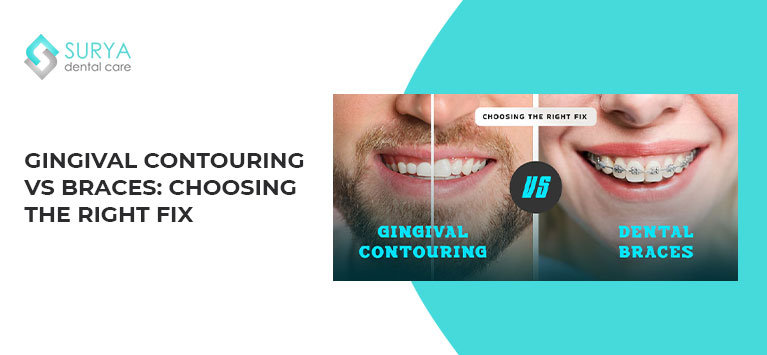Individuals seeking a confident and beautiful smile sometimes find themselves at a crossroads, forced to choose between gingival contouring and braces.
Both gingival contouring and braces operations seek to improve the appearance and functioning of your teeth, but they serve different functions and have their own set of concerns. So, when should you consider gum contouring, and when should you consider braces? Let’s take a look at these two dental interventions to assist you in making an educated selection.
Gingival Contouring
Who needs Gingival Contouring?
While recovering from your gum contouring procedure, you may be prescribed a few days of rest or at least only light activity. This depends on the method used, although, in general, even with a traditional scalpel procedure, gum contouring does not require much downtime.
You may also notice some gum sensitivity for a few days following the treatment, so stick to softer meals like soup, applesauce, or smoothies.
The key takeaway for a successful recovery post-gum contouring is to faithfully heed your doctor’s advice. Additionally, you will likely be scheduled for a follow-up examination after your surgery to ensure there are no signs of infection and to track your recovery’s advancement. In exceptional cases, your physician might suggest an antimicrobial mouthwash to minimize infection possibilities.
Is contouring right?
Gum contouring is a cosmetic surgery performed on patients who feel that they have too much gum or don’t like the curve of their gum line.
However, in some situations, the surgery may be deemed medically essential. If you have periodontal disease and more conservative treatments, such as antibiotics or extensive tooth cleaning, have not helped, this is the most likely scenario.
Your dentist may then recommend surgery to reduce gum pockets or treatment to rebuild gum tissue.
Is it worth getting gum contouring?
If you need gum contouring to treat receding gums or to restore the shape of damaged gums, and this is the procedure your dentist recommends, then it is likely worth it.
When evaluating gum contouring solely for the purpose of aesthetic enhancement, the choice to move forward is entirely yours to make. Irrespective of the outcome, a smile exuding aesthetic appeal has the potential to significantly boost one’s self-esteem.
Even if they occasionally go hand in hand, keep in mind that having a healthy mouth is far more crucial than having an appealing one.
Dental Braces
Teeth braces: when is it necessary?
Dental braces can be used by both adults and children. In the first part of life, up to the last years of adolescence, this tool can prove to be very important for the correct development of teeth and arches. In fact, during the growth of children, in the age group in which the bones are still developing (from approximately 6 to 15 years), the device allows stable and long-lasting results to be obtained.
It is not possible to establish an age at which to start treatment valid for all people, as each individual has unique and specific characteristics. Usually, the first visit should be carried out around the age of 6, the age at which the dentist will evaluate whether to undertake orthodontic therapy. However, in some cases, such as crossbite and mandibular progenism, it may be necessary to intervene even earlier. While in still others, therapy could begin around 10 years of age.
When to get braces on your teeth?
One of the most well-known reasons why you wear braces is dental alignment.
Teeth alignment is not only an aesthetic problem but also affects chewing function and dental hygiene. Having teeth that are not correctly aligned means, first of all, having teeth that are not easily cleaned, which makes some simple daily cleaning maneuvers difficult. This promotes the accumulation of plaque and opens the way to possible tooth decay and periodontal problems.
In particular, dental misalignment can be caused by numerous factors: it can be crooked teeth due to gum conformation, misaligned arches due to disorders related to the development of the maxilla and mandible, and teeth that have moved independently after falling out or the extraction of other teeth, deciduous or permanent.
Orthodontics is employed not only for dental realignment but also for addressing malocclusions, which stem from an unusual alignment between the upper and lower dental arches. To illustrate, consider the following instances:
- Mandibular progenism: when the mandible protrudes further forward than the maxilla. It can also cause pain in the temporomandibular joint and cause chewing and speaking problems.
- Crossbite: occurs when, with the mouth closed, the lower teeth are external to the upper ones. Crossbite often affects masticatory function, forcing the jaw and muscles into an incorrect posture, which, over time, can cause pain.
- Open bite: the upper incisors do not come into contact with the upper ones when the mouth is closed. For this reason, a gap remains between the two arches. The open bite is usually linked to habits, such as thumb sucking, using a pacifier over the age of three, or the interposition of the lips of the front teeth. This also causes so-called “oral breathing,” a condition in which the subject does not breathe through his nose but through his mouth, causing problems also at a systemic level.
- Deep bite: occurs when, with the mouth closed, the teeth of the upper arch excessively cover those of the lower arch. People who have a deep bite may have difficulty pronouncing some words, breathing, and chewing. In some cases, the teeth can also damage the gums and palate, thus causing further problems.
- Increased overjet: occurs when there is a greater than normal distance between the incisal edge (the one used to bite) of the upper incisors and that of the lower incisors. In this case, the upper incisors, being very protruding, are exposed to a greater risk of fracture in the event of trauma.
Factors to Think About When Choosing the Right Fix
- Health and functionality of the teeth: While braces work to improve tooth functioning, gum contouring mostly tackles cosmetic issues. Take into account whether you have any dental health concerns that require care.
- Dental Development and Age: Your age when you seek therapy is very important. While braces can be worn by both toddlers and adults, gum contouring is primarily performed on adults. To find the best time, speak with your dentist.
- Aesthetic Objectives: Examine your main objectives. Gum contouring may be the best option if you want a more even gum line and a pleasing smile. Braces could produce the desired outcomes if your concerns involve crooked teeth and biting problems.
- Commitment through time: Braces call for a more prolonged commitment, sometimes lasting many months or years. Before choosing a course of therapy, think about your ability to follow it.
Conclusion
Your particular demands and objectives will determine whether you should choose braces or gum contouring for dental beauty and functionality. While braces are necessary to fix crooked teeth and bite problems, gum contouring is perfect for people who want to improve the looks of their gum line. Always put your oral health first and get advice from a specialist before making a choice that will result in a happy, healthy smile. The end aim is to have a grin that expresses your inner pleasure and confidence, whether you go for gum contouring or braces.



